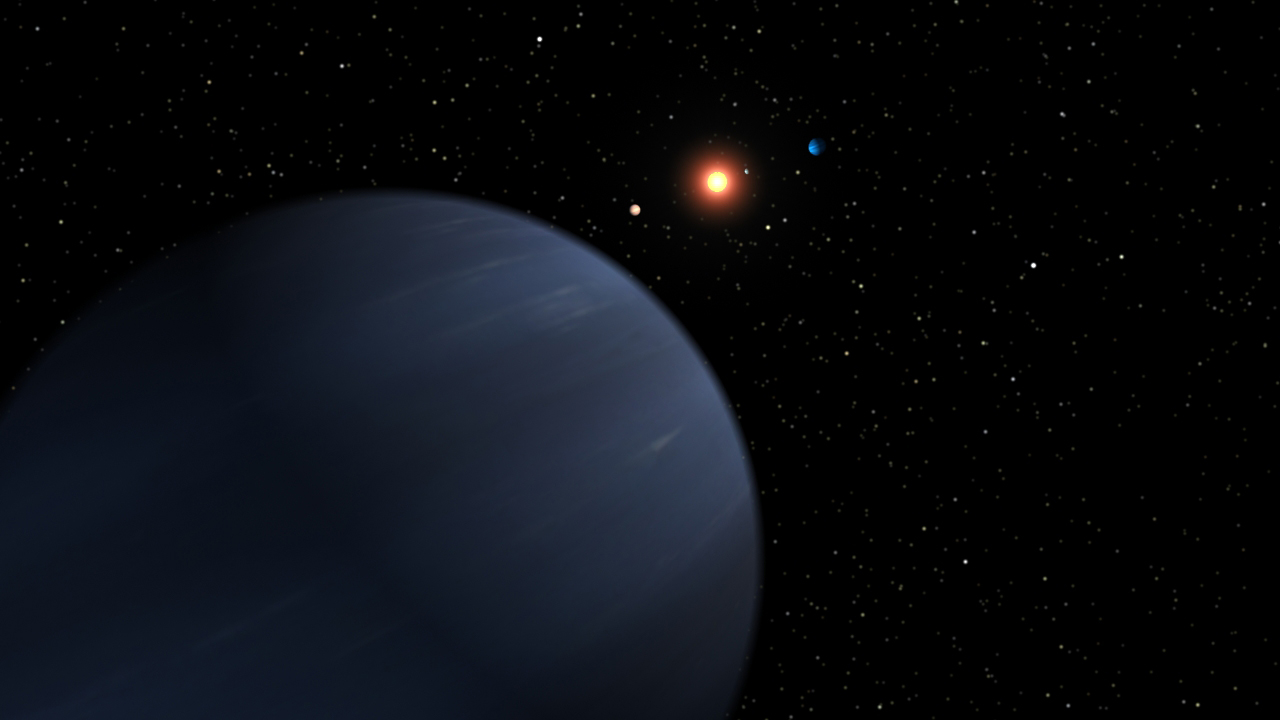- 55 Cancri f
Planetbox begin
name = 55 Cancri fPlanetbox image

caption = An artist's impression of 55 Cancri f.
The stars around its sun are the three innermost planets.Planetbox star
star = 55 Cancri A
constell = Cancer
RA = RA|08|52|35.8
DEC = DEC|+28|19|51
dist_ly = 40.9
dist_pc = 12.5
class = G8VPlanetbox orbit
semimajor = 0.781 ± 0.007cite journal|url=http://arxiv.org/abs/0712.3917 |journal= Astrophysics |title=Five Planets Orbiting 55 Cancri| author=Debra A. Fischer, Geoffrey W. Marcy, R. Paul Butler, Steven S. Vogt, Greg Laughlin, Gregory W. Henry, David Abouav, Kathryn M. G. Peek, Jason T. Wright, John A. Johnson, Chris McCarthy, Howard Isaacson| date=2007-12-23 |accessdate=2008-09-17]
eccentricity = 0.2 ± 0.2
period = 260.00 ± 1.1
ang_dist = 58.3
long_peri = 181.1 ± 60
t_peri = 2,450,080.9108 ± 1.1
semi-amp = 4.879 ± 0.6Planetbox character
mass = >0.144 ± 0.04Planetbox discovery
discovery_date =11 April 2005 (announced)6 November 2007 (published)
discoverers = J. Wisdom
discovery_method =Doppler spectroscopy
discovery_site = flag|United States
discovery_status = PublishedPlanetbox catalog
names = Rho1 Cancri f, HD 75732 f55 Cancri f, also referred to as Rho1 Cancri f, is an
extrasolar planet approximately 41light-year s away in theconstellation of Cancer (theCrab ). 55 Cancri f is the fourth known planet (in order of distance) from the star55 Cancri and the first planet to have been given the designation of "f". [cite web|url=http://astrobiology.nasa.gov/articles/researchers-identify-first-five-planet-extrasolar-system/ |title=Researchers Identify First Five-Planet Extrasolar System |publisher= NASA Astrobiology |date=2007-11-12|author=Shige Abe |accessdate=2008-09-17] As of September 2008, this makes 55 Cancri the onlyplanetary system outside theSolar System that is known to contain at least 5 planets. [cite web|url=http://exoplanet.eu/catalog-all.php |title=The Extrasolar Planets Encyclopaedia |publisher=Exoplanet.eu |date= |accessdate=2008-09-14]Discovery
The initial presentation of this planet occurred at a meeting of the
American Astronomical Society inApril 2005 , [cite journal |author=J. Wisdom |url=http://www.aas.org/publications/baas/v37n2/dda05/29.htm |archiveurl=http://web.archive.org/web/20061216012023/http://www.aas.org/publications/baas/v37n2/dda05/29.htm |archivedate=2006-12-16 |title=A Neptune-sized Planet in the rho1 Cancri System |accessdate=2008-09-17 |publisher=The American Astronomical Society |date=2005-04-11| journal=DDA 36th Meeting, 10-14 April 2005—Session 5 Posters] however it was another two and a half years before the planet was to be published in a peer-reviewed journal. Unlike the majority of known extrasolar planets, 55 Cancri f was detected by a third party, by reviewing already-published data on the star and analyzing observed changes in itsradial velocity (obtained by measuring of theDoppler shift of the star'sspectrum ).Orbit and mass
55 Cancri f is located about 0.781 AU away from the star which takes 260 days to complete.cite web|url=http://exoplanet.eu/planet.php?p1=55+Cnc&p2=f |title=Notes for Planet 55 Cnc f |publisher="The Extrasolar Planets Encyclopaedia"|date= |accessdate=2008-09-14] A limitation of the radial velocity method used to detect 55 Cancri f is that only a
minimum mass can be obtained, in this case around 0.144 times that of Jupiter, or 2.67 times the mass of Neptune. A Keplerian fit to the radial velocity data of 55 Cancri A indicates that the orbit is consistent with being circular, however changing the value in a range between 0 and 0.4 does not significantly alter thechi-square statistic of the fit, thus a representative eccentricity of 0.2±0.2 was assumed. In a Newtonian model which takes interactions between the planets into account, the eccentricity comes out as 0.0002, almost circular.Astrometric observations made with the
Hubble Space Telescope suggest that the outer planet55 Cancri d is inclined at 53° with respect to the plane of the sky. [cite journal |url=http://www.obspm.fr/encycl/papers/mas_caps_final_formated.pdf |author=Han, I. et al.|title=Preliminary Astrometric Masses for Proposed Extrasolar Planetary Companions|journal=Astrophysical Journal |volume=548|pages=L57 – L60|year=2001|doi=10.1086/318927] If these measurements are confirmed and the system is assumed to be coplanar, thetrue mass of the planet would therefore be about 25% greater than this lower limit, at around 0.18 Jupiter mass.Characteristics
Since the planet was detected indirectly through observations of its star, properties such as its
radius , composition andtemperature are unknown. With a mass half that ofSaturn , 55 Cancri f is likely to be agas giant with no solid surface. It orbits in the so-called "habitable zone ," which means that liquid water could exist on the surface of a possible moon. [cite web|url=http://www.guardian.co.uk/science/2007/nov/07/spaceexploration |title=Could this be Earth's near twin? Introducing planet 55 Cancri f |publisher="The Guardian" |author=Sample, Ian |date=2007-11-07 |accessdate=2008-09-17]References
See also
*
55 Cancri b
*55 Cancri c
*55 Cancri d
*55 Cancri e External links
*
*
Wikimedia Foundation. 2010.
